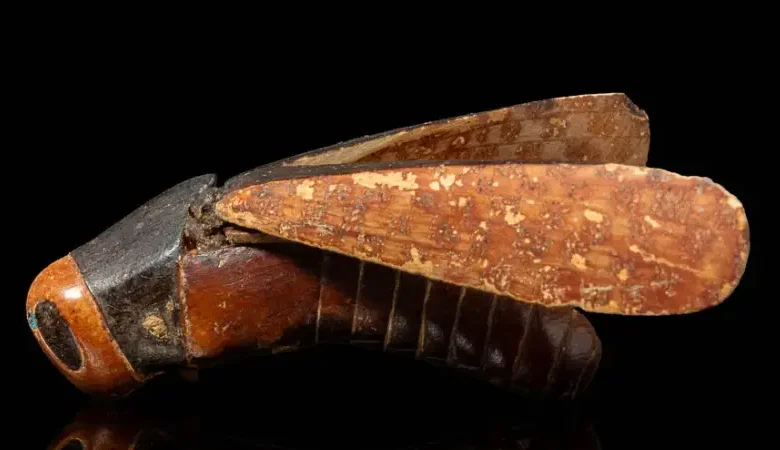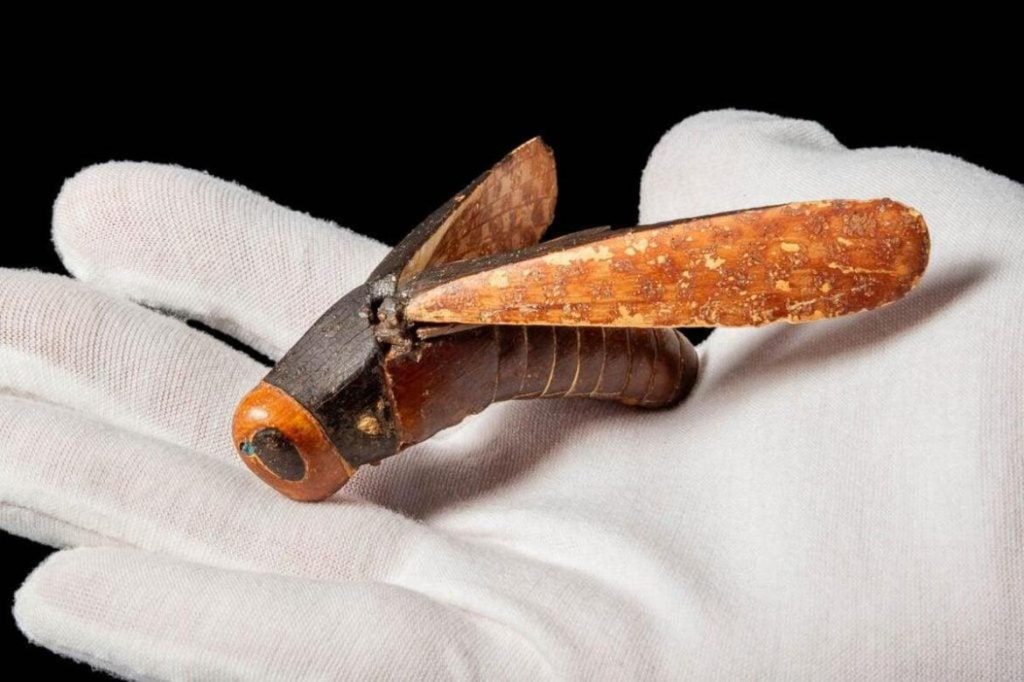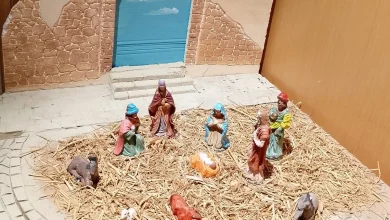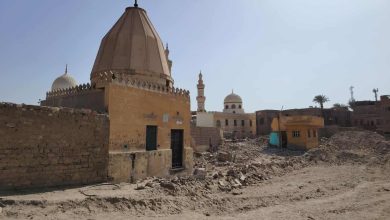
Owned by an Arab prince… The full story of the sale of an artifact believed to have been stolen from Tutankhamun’s tomb
“The Egyptian Grasshopper” sparks controversy at a London auction
On July 27, Apollo Auction House held an auction in London to sell a rare Egyptian cosmetic vessel known as the “Genoula Genoula,” made of wood and ivory. The auction ended with the piece selling for £340,000 (US$455,000), equivalent to a third of its value when it was sold in 2007.
Despite the auction house’s assertion that it is “a piece from the Tutankhamun era,” many experts pointed out that it originally belonged to Tutankhamun’s tomb, raising questions about the legitimacy of its sale, how it left the tomb discovered intact by Howard Carter in 1922, and its whereabouts for a century, especially after Christie’s and Sotheby’s auction houses refused to offer it for sale.
Apollo
The piece is lot number 462 in the auction and is listed under the heading: “Fine Ancient Arts and Antiquities – The Prince’s Collection.” Apollo is a relatively new auction house in the ancient art trade.
The auction house’s official website describes the piece as: “Offering collectors and historians a glimpse of the fine art of the modern state of Egypt. The piece dates back to the late 18th Dynasty (circa 1350-1340 BC).”
As for its characteristics, it weighs less than 20 grams and is carved from painted ivory with wood inlays, and its eyes are decorated in blue and black. Its wings are decorated with chessboard-like patterns that curve outward, revealing a small cavity that was used to store kohl or perfume.
Suspicious auction
According to Luxury Lunch magazine, this piece, in the shape of a grasshopper, is estimated to be worth around $1.2 million.
It was first offered at Christie’s and Sotheby’s auctions, but both refused to sell it without giving a reason.
The magazine pointed to the possibility that the piece was looted from Tutankhamun’s tomb. It is less than 9 cm (three and a half inches) long and dates back to between 1350 and 1349 BC.
Conflicting information
Dar Apollo denied that the piece had been looted from the tomb. It said: “The connection to Tutankhamun’s tomb is a recent scientific hypothesis, not an established fact. It therefore does not constitute legal or historical evidence.”
It justified its position by stating that there was no photograph of the piece in the tomb excavations, nor was it included in Carter’s inventory lists. There are no documents proving its connection to the tomb.
However, it was mentioned in the printed auction catalog (page 8): “The grasshopper is believed to be among the known or possible pieces from the tomb of Tutankhamun. It was once part of the collection of the late Howard Carter.”

Did Carter steal it?
Some experts believe that the piece does indeed belong to the tomb, given its similarities to the artistic characteristics of Tutankhamun’s era. The magazine reported that archaeologist Howard Carter had seized a number of small, beautiful pieces from the tomb. It emphasized that these artifacts belonged to the Egyptian people and that he had no right to acquire them, either secretly or openly.
This is not the first piece to be the subject of suspicion. According to the Apollo art website (which is different from the auction house), Carter had promoted the sale of many pieces attributed to Egyptian tombs until his death in 1939. A large collection of them was found in his apartment in Kensington, believed to be from the same tomb.
Harry Burton, who worked at the Metropolitan Museum, carried out Carter’s will. He returned all items bearing the name Tutankhamun to the Egyptian Embassy in London and sold the rest. Collectors and museums, including the Metropolitan Museum, purchased some items that Carter’s personal notes (now lost) indicated came from the tomb.
Historical references
The Apollo website notes that this piece has a long history, with a number of curators and museum directors denying that it came from Tutankhamun’s tomb. Museum curator Alistair Bradley Martin classified the piece as possibly coming from western Thebes. The “Egyptian Grasshopper” was one of his favorite pieces. Cartoonist Charles Adams even depicted him buying it from a shady dealer who assured him, “This grasshopper is cursed.”
Thomas Hoving, director of the Metropolitan Museum between 1967 and 1977, mentioned the piece in his 1978 book Tutankhamun: The Untold Story as part of the tomb’s holdings. He based this on documents from the museum’s archives and interviews with senior curators who knew Carter and Burton. In 2010, the Metropolitan Museum returned some of the disputed pieces. However, many of the pieces that Hoving identified as looted from the tomb are still on display at the museum.
Who owned the “Egyptian Grasshopper”?
The sudden appearance of the piece at auction raises an important question: “Where has this piece been all these years?” Although the auction house insists there is no evidence it was stolen, some experts have questioned its provenance.
According to Artnet, the piece passed through the hands of archaeologists, dealers, collectors, and members of the royal family. It is believed that Carter first sold it to Egyptian dealer Maurice Nahman. It then passed to New York dealer Joseph Bromer in 1936, and after his death it was sold at auction in 1948. It then became part of the collection of Alistair Bradley Martin.
Martin paid around $10,000 for it. It was then included in the legendary “Ginul Collection,” owned by Martin and his wife Edith, who was the curator of the Brooklyn Museum. According to the official website of Apollo, the piece was exhibited at the Brooklyn Museum between 1948 and 2002. It was also exhibited at the Metropolitan Museum in 1969.
Imaginative prices
The Ginoul collection is estimated to be worth a fortune. In December 2007, a limestone statue of a lion, dating from between 3000 and 2800 BC, was sold for US$57.1 million, plus additional fees of US$18 million, at Sotheby’s auction house in New York.
The auction house noted that the piece “has since been cited in many important academic references, such as Cyril Aldred’s The Art of the New Kingdom in Ancient Egypt (1951) and Charles Singer’s History of Technology (1954).
Qatari prince’s collection
In 2007, the piece was acquired by Merrin, then purchased by Sheikh Saud Al Thani, a member of the Qatari royal family. He died in 2014, for $1.2 million, according to Apollo magazine.
Sheikh Saud was known for his love of acquiring rare and exotic artifacts, often overlooking their provenance. In 2005, he was placed under house arrest on charges of embezzling public funds in Qatar to build his private collection of antiquities.
He also bought a large number of pieces from convicted dealer Robin Symes. Since his death, his heirs have been trying to sell his huge collections, but they often receive only a fraction of the amounts he paid during his lifetime.
The trade in antiquities
The sale of the piece known as the “Egyptian Grasshopper” has highlighted the loopholes in the regulations governing the trade in antiquities. This is particularly true in light of the controversy surrounding Howard Carter’s theft of a number of pieces from the tomb of King Tutankhamun, some of which are still missing.
According to the British newspaper The Observer, Egyptologist Tom Hardwick said: “There is a legal market for well-documented Egyptian material, but buyers should be aware that the grasshopper is a suspect piece.”
He added: “This piece has been identified and sold as coming from the tomb of Tutankhamun, and I believe it belongs to Egypt. Now that the scarab has appeared on the open market, any buyer will face increasing legal and ethical pressure to return it.”
Request for return: legal obstacles
Under UK law, three conditions must be met in order to request the return of an artifact: proof that it was obtained illegally, that it was exported illegally, and that the request was made in a timely manner. The request must be made in a timely manner. This has not happened in the more than 80 years since the piece was first publicly displayed, according to a spokesperson for Apollo.
The spokesperson said: “Although the artifact dates back to the time of Tutankhamun, there is no evidence linking it to Carter. It does not appear in any official excavation records.“
He added: ”References to it in subsequent academic works are mere speculation. It was exported from Egypt in the 1930s, decades before the 1970 UNESCO Convention and the 1983 Egyptian Antiquities Law.”
Searching international records
James Ratcliffe, legal advisor and director of recovery operations at Apollo, said the company had requested a comprehensive search for the grasshopper. It searched a database of privately owned art and antiquities.
He added: “This grasshopper is not listed there or in the Interpol database. It is a small but important piece, we checked its provenance and searched for information about its previous sales.” Ratcliffe explained that the key issue was whether Egypt had requested the return of the grasshopper. “The piece has been on public display for decades,” he said. There has been some controversy, but since no one has requested it, we cannot take action on it.”
He concluded by agreeing with theories that Carter stole many artifacts from Tutankhamun’s tomb. However, he does not know if this piece was among them, especially since it has been sold several times with its provenance attached.
Read also
An exhibition in Paris reimagines Cleopatra, far from Western narratives
Art auction to support Darb 1718 after its headquarters were demolished: artists give back




